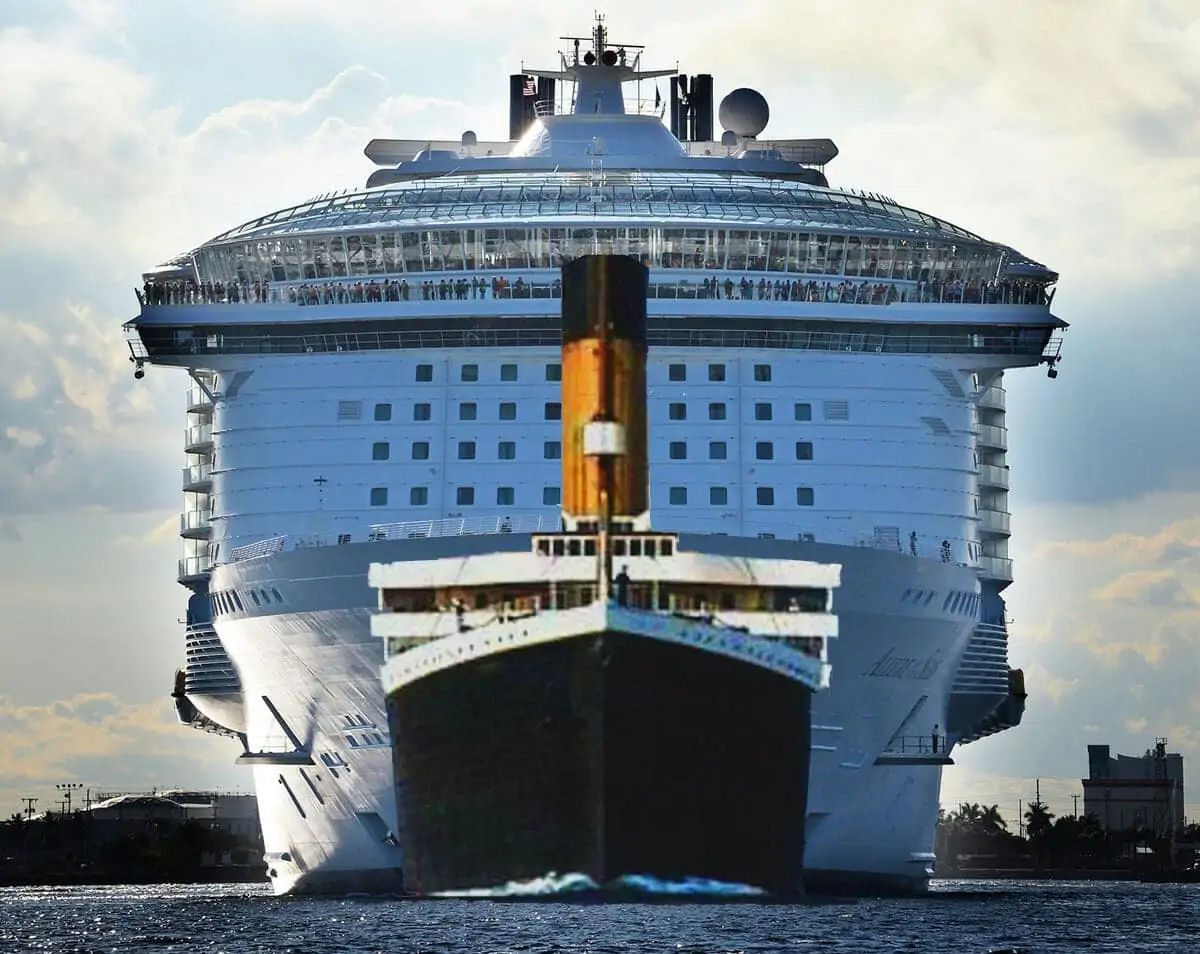Table Of Content

On the other hand, second-class staterooms provided a relatively comfortable experience with small cabins and basic decor. The rooms were more modest than the first-class cabins but provided a comfortable stay for middle-class passengers. Despite their luxury accommodation, many first-class passengers shared communal bathroom facilities. Additionally, freshwater aboard the vessel was scarce, meaning guests of all classes bathed in seawater. By today’s standards, the Titanic wouldn’t even make the top 100 cruise ships in the world. Modern-day cruise ships, such as the Oasis-class cruise ships, are about a third longer and about double the width of the Titanic.
What is the weight of the largest cruise ship today compared to the Titanic?
Even Royal Caribbean’s smallest ship, the Majesty of the Seas, has a beam of 105 ft. (32 m), which still exceeds the Titanic’s width by quite a lot. The only ocean liner sailing as a cruise ship today is Cunard’s Queen Mary 2, which offers a similar and historic transatlantic route. Actually, Cunard Line purchased the White Star Line (which built the Titanic) in 1950. In comparison, the QM2 is 1,132 feet in length, 148,528 GRT and consists of 18 total decks. In short, Icon of the Seas and Titanic don't have a ton in common besides being ocean going vessels.
Royal Caribbean Dining Package: Costs and Review
To cater to the growing demand for immersive experiences, modern cruise ships have embraced virtual reality (VR) technology. Passengers can step into a virtual world and embark on thrilling adventures without leaving the ship’s premises. Whether it’s exploring ancient ruins or diving into the depths of the ocean, VR experiences provide an extra layer of excitement and entertainment. One of the most significant differences between the Titanic and modern vessels lies in their propulsion systems. The Titanic, a marvel of its time, relied on a traditional steam-powered engine to propel itself through the water.
Second Class Cabins
Unlike cruise ships which are often a destination in and of themselves, ocean liners serve as a means of transportation. The Titanic’s captain, Edward Smith, canceled the scheduled lifeboat drill the day the ship encountered the iceberg. In contrast, modern cruise ships routinely conduct lifeboat drills shortly after embarkation, familiarizing passengers with evacuation procedures and mustering points in the event of an emergency. Modern cruise ships are, on average, 20% longer than the Titanic and twice as tall. Icon of the Seas is the largest cruise ship in the world and is five times the size of the Titanic, with an internal volume of 250,800 GT. Among the conversation on social media, other facts, graphics and images began to emerge, including size comparisons of the Titanic and modern cruise ships, which came as a shock to many.
Titanic vs. Modern Cruise Ship – FAQ
Modern cruise ships offer extensive accommodation options, even though I get confused sometimes. From their ordinary staterooms and cabins to their junior suites and grand suites that are nearly 2 to 3 decks high. You can consider the Royal Caribbean Icon of the Seas that expands across 1,196 feet, and its width is 65 meters (213 feet), and it’s one of the largest cruise ship in the world. Changes in shipbuilding have allowed modern cruise ships to far surpass the height and tonnage of the Titanic.
Q4: Can I expect high-quality dining experiences on modern cruise ships?
The Symphony of the Seas’ GT is five times larger than that of the Titanic at 228,081, while its NT is 258,794, and its DWT is 18,095. Gross tonnage (GT) is the total molded volume of the enclosed spaces of a ship, calculated by measuring it from the keel to the funnel, the stern to the bow, and to the outside of the hull framing. It is a replacement for gross register tonnage (GRT), the unit of measurement used during the time of the Titanic.
How Big is a Cruise Ship? (2023) Cruise.Blog - Cruise Blog
How Big is a Cruise Ship? ( Cruise.Blog.
Posted: Tue, 20 Jun 2023 07:00:00 GMT [source]
And with the Titanic’s 46,328 GT against Icon of the Seas’ 250,800, that’s where we can see just how stark the difference is. Here’s a list of just some of the cruise ships that are very similar to the Titanic. Of course, there are some ships much larger than this again, but there are a lot of ships that have a passenger capacity between 3,000 and 3,500 so the super-ships don’t skew these averages too much.
Construction Costs
But in 1912, when commercial flights weren’t a thing (the first aircraft was only successfully trialed 9 years earlier), passenger ships were the default option for long-distance travel. Titanic can hold its own when comparing its speed to modern-day cruise ships, as she had a maximum speed of 23 knots, which is roughly 26.5 miles per hour. Historical records show that the Titanic sailed around 22 knots on average. That being said, it's interesting to see the comparison between the Titanic and modern-day cruise ships that are double, triple, and even quadruple in size. The current, largest, in-service cruise ship is Royal Caribbean’s Symphony of the Seas. It measures 228,081 GT, with 18 decks and a passenger capacity of 6,680 passengers and a crew of 2,200.
Oasis Of The Seas Vs. Titanic
One of the biggest differences between the Titanic and modern cruise ships is the technology that is used. The Titanic was built in 1912, and at that time, there were no radar systems, satellite communication, or other advanced technologies that modern cruise ships have. Additionally, modern cruise ships have much more advanced safety features and emergency procedures in place. When it comes to facilities and amenities, modern cruise ships have come a long way since the Titanic.
Modern cruise ships offer an array of outdoor activities that were simply not available on the Titanic. From water slides and zip lines to mini-golf courses and sports courts, there is no shortage of ways to stay active and enjoy the fresh air while onboard a modern cruise ship. The difference between the Titanic era and modern cruises is like night and day. Back then, limited navigational aids made it challenging to detect potential hazards in advance.

Even so, there were fewer first-class rooms than there are suites onboard newer ships. A previous shipping line, White Star operated multiple passenger ships, but today is known best for its losses. Beyond the sinking of the Titanic, it also lost the HMHS Britannic and the Republic, all in a 10-year period. Still, those second-class passengers still had their linens changed daily, and there was a sink in each cabin, even if the restrooms were communal. After all, if the Titanic was a huge ship just about a hundred years ago, surely it is still at least a moderately large ship by today’s standards… right?
Technological advancements allow modern cruise ships to be built to unthinkable proportions in the early 20th century. Not only did the designs call for the ship to be one of the world’s largest ocean liners, but the ship was to be the pinnacle of comfort and luxury for passengers. From the moment the keel was laid in March of 1909 until the day she was completed on April 2, 1912, over 15,000 men had worked on constructing and outfitting the ship. The sinking of the Titanic happened over 100 years ago and although she was the largest ship at the time of her launch a lot has changed since. Modern cruise ships are, on average, 20% longer than the Titanic and twice as high. The average Royal Caribbean cruise ship is 325 meters long, 14 decks high and has a gross tonnage of 133,000.
Overall the average cruise ship has come a long way in terms of safety, with regulations and standards improving significantly over the years. Modern cruise ships are subject to much more rigorous safety requirements and have taken significant steps to reduce the risk of accidents or other incidents. While there is room for improvement, the industry has made great strides in ensuring that passengers are safe while onboard. The main way that modern cruise ships are able to be so much larger than the Titanic is because they are so much higher. It would be natural to assume that modern cruise ships would all be larger than the Titanic, since they’re all around a century newer. While the Titanic may be slightly longer than the average cruise ship today, she has a much smaller gross tonnage, because she wasn’t as wide nor was she as tall.
However, the White Star Line chose to make both luxury and comfort key components of the Titanic. This helped differentiate Titanic from other ocean liners being built by Cunard Cruise Line, which was the White Star Line’s biggest competition at the time. Today, cruise ships are built in smaller sections kind of like LEGOS and loaded onto large cranes. These chunks are pieced together one by one, which allows the engineering process to be much faster than traditional building methods. A la Carte Restaurant was open to first-class passengers only and was one of the earliest examples of for-a-fee dining on a cruise ship (really!). An alternative to the main dining room, it was smaller and served the most fashionable of French decor.
Back in the day, safety regulations were not as stringent as they are today. The tragic sinking of the Titanic in 1912 highlighted some major shortcomings in terms of safety features onboard. This meant that when disaster struck, there simply weren’t enough life-saving vessels to accommodate everyone on board.
Because of the limited freshwater, there was no laundry service aboard the Titanic. Perhaps the most striking difference between the Titanic and modern cruise, apart from the sheer difference in size, is the quality of cabins and the range of activities and entertainment. That may sound like a lot of money, but it pales compared to how much it costs to build a cruise ship. The Oasis-class ships we have reviewed are big enough to contain the Titanic itself. Despite this, because of Titanic’s place in history, it will always remain as the largest ship ever built, at least in our collective memory, but not in actual fact.

No comments:
Post a Comment